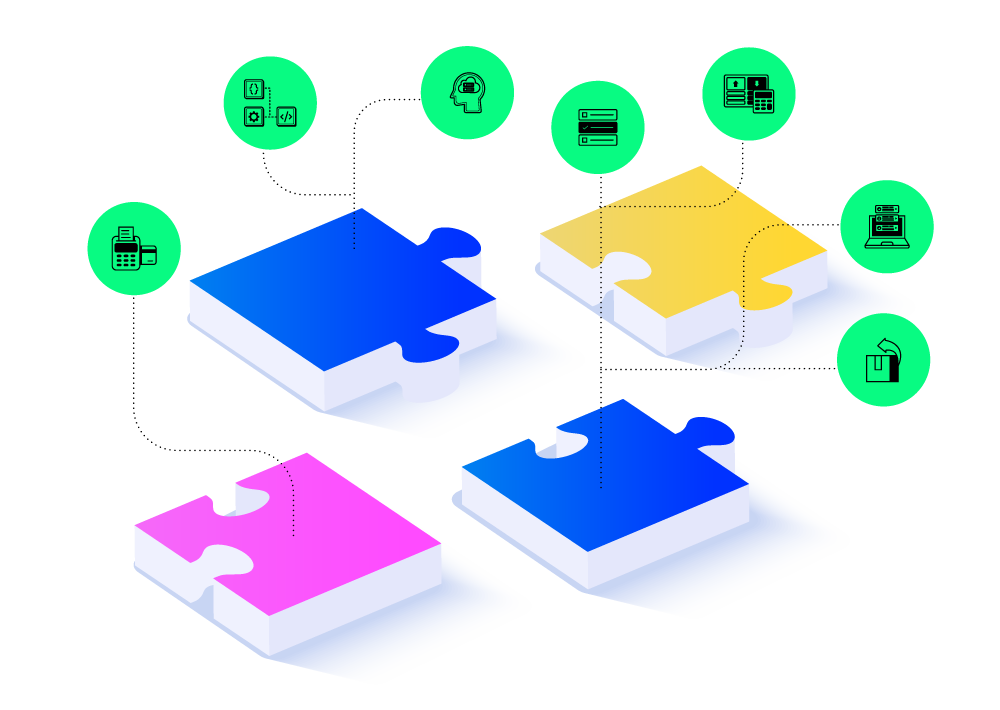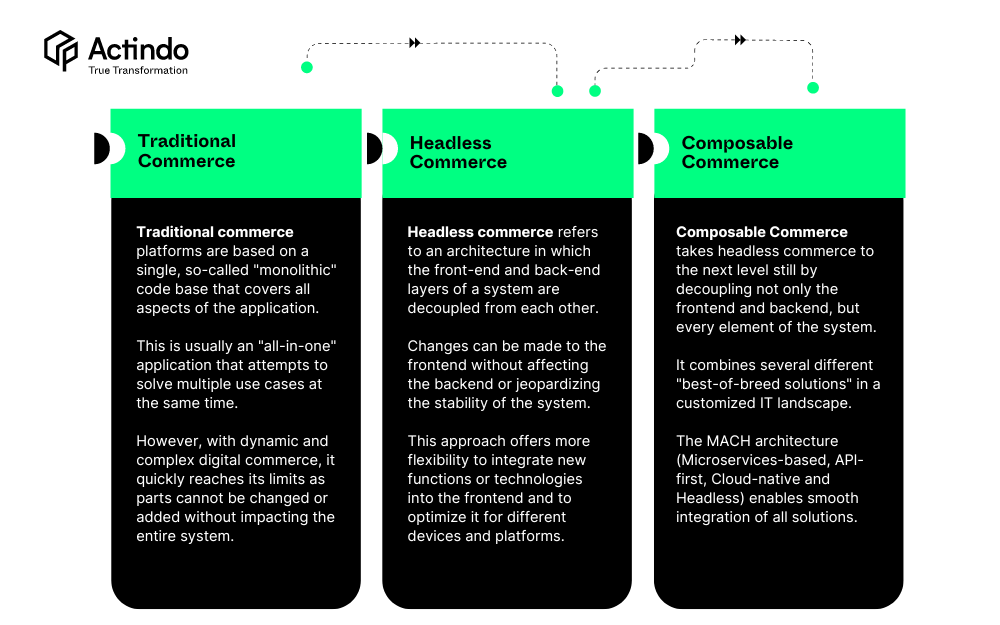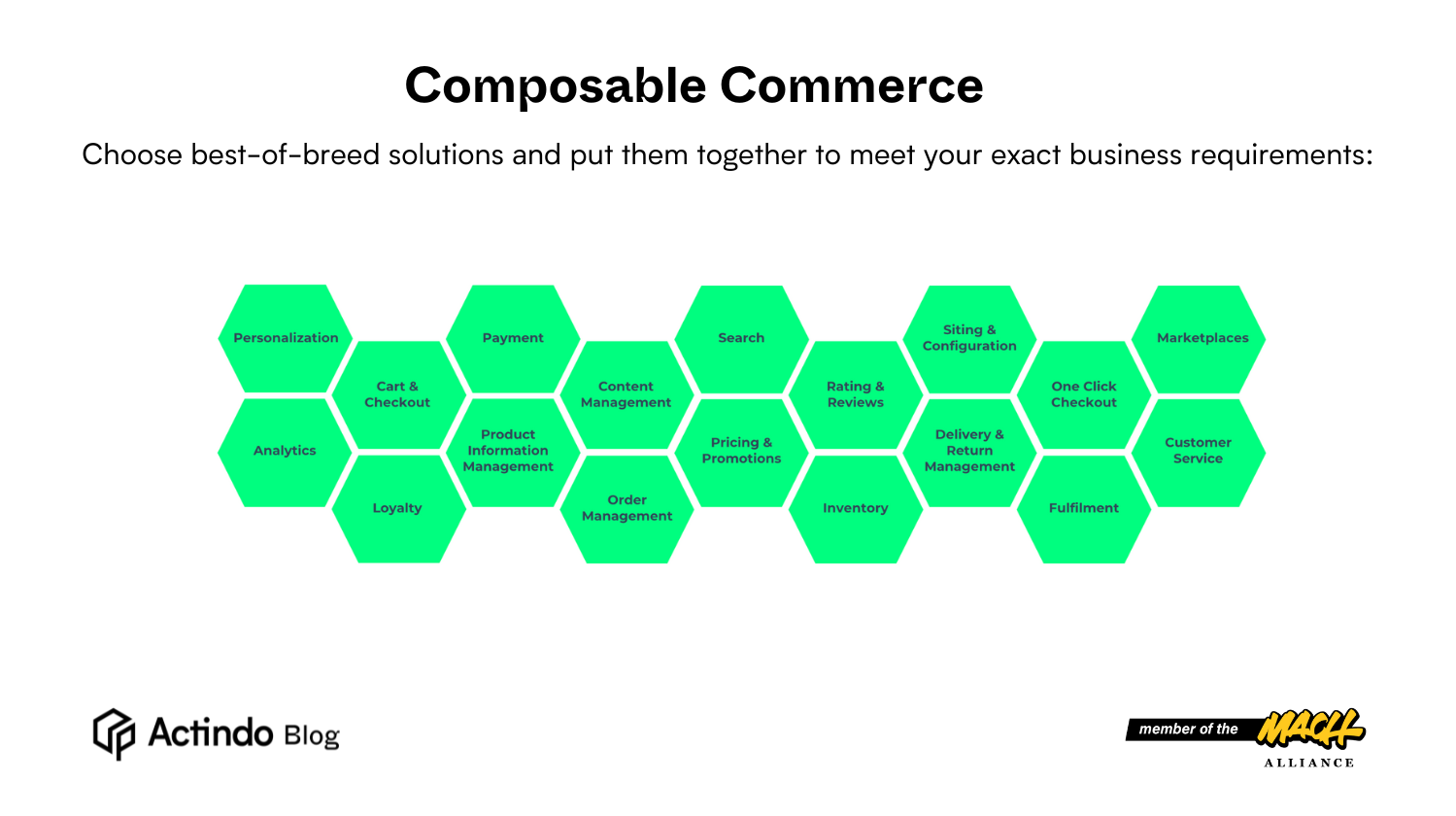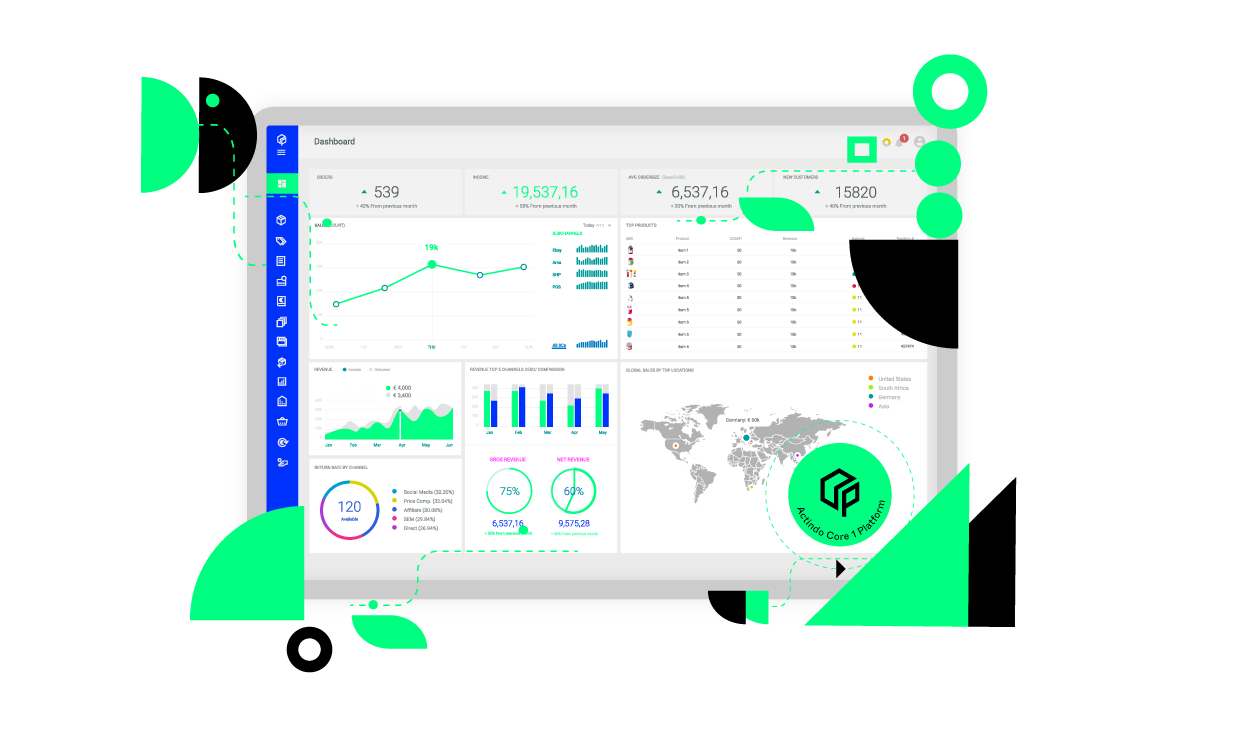AI in E-Commerce: Examples, Benefits and How to Get Started
Discover the potential of AI in e-commerce, see some compelling examples, and learn how to leverage it with this comprehensive guide from Actindo.

The global e-commerce market is expected to reach an incredible $6.3 trillion in 2024.
As the online retail market booms, Composable Commerce is rapidly winning favour with brands, retailers and manufacturers who want to offer their customers personalized experiences, and tailor their e-commerce platforms. In this guide, we'll explain everything you need to know.
Composable Commerce is a concept coined by Gartner which enables businesses to build scalable and customizable e-commerce platforms that best fit their unique requirements.
At the same time, it opens up new opportunities for companies to keep pace with the latest e-commerce trends, build long-term customer relationships and increase sales.
Composable Commerce is a software architecture that separates the front-end and the back-end of a business, allowing you to pick and mix best-of-breed technologies and build a flexible, agile architecture.
It leverages modern technologies like MACH (Microservices, API, Cloud, Headless) and JAMstack (JavaScript, APIs, and Markup) to make it truly modern and future-proof.
The front-end and back-end of the software communicate via API, and each component on the platform can be replaced without critically impacting other parts of the system.
Unlike monolithic commerce platforms, in Composable Commerce you can choose components from different vendors and compose them into a single platform. These components are called Packaged Business Capabilities (PBCs).
Packaged Business Capabilities (PBCs) are often confused with "microservices". These two terms are similar and complementary, but not the same.
Microservices can be understood as the small functions or features of a platform, while Packaged Business Capabilities are a collection of microservices. As the name suggests, PBCs are built around providing a specific business function through clear and well-defined business tasks.

Whereas traditional commerce platforms are inflexible and incapable of handling the growing demands of a business, Composable Commerce platforms allow businesses to build an agile commerce platform designed for modern touchpoints, leveraging Packaged Business Capabilities.
A common question is how traditional commerce platforms differ from headless commerce and composable commerce. Take a look at the following visual explainer:

Traditional commerce platforms are based on a single, so-called "monolithic" code base that covers all aspects of the application . This is usually an "all-in-one" application that attempts to solve a number of commerce use cases at once.
However, as digital commerce becomes increasingly dynamic and complex, monolithic platforms quickly reach their limits, as parts cannot be changed or added without impacting the entire system. This severely limits the ability to adapt, respond to change and grow the business.
Headless commerce platforms gradually emerged in the early 2010s. With headless technology, front-end and back-end applications are decoupled from each other.
Changes can be made to the front-end without affecting the back-end or jeopardizing the stability of the entire system. This approach offers more flexibility to integrate new functions or technologies into the frontend and optimize it for different devices and platforms.
The switch to headless was the first decisive step in breaking up monoliths and making IT platforms more flexible, agile and future-proof. However, legacy systems can be "headless" but not based on microservices, which means that they work with a monolithic architecture in the back-end.
Composable commerce takes headless commerce to the next level by decoupling not only the front-end and back-end, but every element of the system. This enables the combination of several different "best-of-breed solutions" in a customized IT landscape.
The MACH architecture (microservices, APls, cloud and headless) enables smooth integration of the solutions. With a system that can be flexibly and easily integrated and exchanged, companies can become agile and highly responsive to changing customer needs. They can combine all channels and touchpoints to create delightful, memorable customer journeys.
Composable Commerce is an approach that allows businesses to build a customized e-commerce platform using Microservices, rather than a traditional commerce platform. It offers several benefits, including:

Overall, Composable Commerce provides a more flexible, efficient, and cost-effective way for businesses to build and manage their e-commerce platform, allowing them to quickly adapt to changes in the market and provide a better user experience.
"Only an entire technology landscape can be composable, never a single tool, " said Maximilian Schunk, Partner Manager at Algolia in one of our recent partner interviews.
"However, you should never lose sight of the 'business value', and prioritize accordingly. In concrete terms, this means: which pain points do I address with a particular tool? Which component has an effect on my bottom line? What is the ROI and time-to-value of an individual tool?"
Composable commerce’s biggest strength is being able to customize your own e-commerce setup, fast. To perfectly meet the needs of your business, now and in the future. It allows you to pick and choose the components and functions you need, and isn’t limited to the basic functions of an all-in-one suite.
Moreover, it avoids causing a "system chaos" due to fragile point-to-point connections. Thanks to innovative MACH architecture, every application is seamlessly integrated as part of your e-commerce platform for a powerful, optimally networked IT ecosystem.
Composable Commerce focuses on uniqueness and differentiation. You can choose the systems that are perfectly aligned with your business - from your store system to your CRM, to payment and shipping providers.
Your entire e-commerce tech stack becomes leaner, faster, more flexible, and much easier to maintain. This not only simplifies your work but also creates an exceptional customer experience across all channels.
>> Read our guide to ERP for E-Commerce <<
Renowned German lifestyle brand Kapten & Son successfully implemented composable commerce to open up new sales channels, create seamless customer journeys and centrally control all processes at every touch point.
In 2022, the well-known fashion company decided to partner with Actindo. The aim: to future-proof the company's operational and IT structures for its ambitious growth targets.
The project was completed in just 12 weeks and enabled Kapten & Son to implement seamless omnichannel processes across all sales channels, and increased capacity to confidently handle large order volumes during peak season like Black Friday.
The Actindo Core1 platform enabled Kapten & Son to unify all sales channels and connect with various composable commerce providers for store, mailing, fulfillment, payment and more to create a best-of-breed architecture tailored to the company's specific needs.
Transitioning a traditional IT landscape to a Composable Commerce platform requires careful planning and implementation to ensure that the platform meets all business requirements and can be used optimally.
We recommend the following steps to switch to a Composable Commerce platform:
It's important to work with a team of experienced developers and consultants to ensure a smooth transition and successful implementation.
At Actindo, we expect to see these three trends in the next 12 months:
1. Democratization of composable commerce: More and more cost-effective applications and integration options are entering the market. Small and medium-sized businesses will adopt these composable tools and start benefitting from the latest best-of-breed technologies.
2. Mass implementation of AI technologies: Composable tech and generative AI are about to fundamentally change the landscape of e-commerce. For example, Gartner names generative artificial intelligence as one of the most important strategic technology trends for 2024.
"In 2024, I expect to see new tools powered by AI that will make it easier for e-commerce businesses to get more done with less time," says expert Connor Gillivan, founder of TrioSEO. "The only caveat is that we must not rely blindly on AI tools. Rather, it's a combination of humans + AI that will create the biggest wins."

3. Legacy systems will be removed: Forrester's Emily Pfeiffer predicts that by 2024, at least a quarter of spending on digital technologies will shift from maintaining outdated systems to smaller, targeted projects.
Given the enormous financial challenges posed by legacy systems, this forecast is hardly surprising. A recently published research report by the MACH Alliance shows that the cost of upgrades is a perennial problem for businesses, with companies whose IT ecosystems are more than 75 percent outdated spending 71 percent of their budgets on upgrades.
At Actindo, we've long recognized the trend towards modular IT. With our Actindo Core1 platform, we offer a flexible all-in-one solution that makes it possible to integrate and centrally control all touchpoints as well as existing (legacy) systems.
The integrated DataHub standardizes data streams from various sources and sales channels and bundles them centrally in one place. All previously separate data communicates seamlessly with each other, and is available to teams collaboratively and in near real time in one place.

By creating individual workflows and orchestrating business processes across channels, the customer journey can be personalized, processes streamlined, the workload on your own team reduced and business value increased.
Actindo Core1 is based on the innovative MACH+ architecture and offers a modular retail structure and an innovative headless ERP strategy. It can be used both as a central solution and as a scalable layer on top of existing systems, making it easy to modernize traditional legacy IT.
Switching from a traditional ERP system to a Composable Commerce approach doesn't need to be a costly mammoth project. Reliable legacy systems can be easily integrated into the modern commerce environment and linked to modern applications with Actindo's Digital Operations Platform.
If you're interested in getting started with Composable Commerce, book a 30-minute demo call with our experts to find out how. In the call, our experts will give you a full overview of the Actindo Digital Operations Platform and address all your individual requirements and questions.
Composable Commerce offers a new approach to creating and managing e-commerce experiences that is flexible, scalable, and future-proof.
By breaking down traditional monolithic platforms into smaller, specialized services, businesses can leverage the best-in-class capabilities of each component, enabling them to innovate and respond to changing customer needs faster than ever before.
Gartner predicts that companies which choose to deploy Composable Commerce will outperform their competitors by 80% in the implementation of new functions.
Discover the potential of AI in e-commerce, see some compelling examples, and learn how to leverage it with this comprehensive guide from Actindo.
Full flexibility, cost efficiency and seamless customer experiences - MACH principles offer huge benefits for e-commerce retailers
Actindo gets the MACH certification for modern interoperability as one of the most innovative and flexible Digital Operations Platform.
Actindo's Commerce Operations Platform: Seamlessly unify channels,
orchestrate orders & delight your customers.